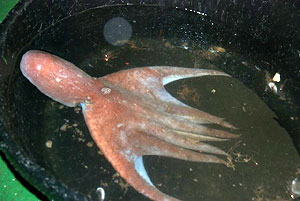

 | |||||||||||
|
|
Journals 2008/2009Megan O'Neill
April 27, 2009 Because we needed to keep the fishing attempts going continuously, we had to break into two groups. The first being midnight to noon and the second, noon to midnight. I got the midnight to noon with Dr. Sidell and Jeff Grim, while Jody Beers and Dr. Crockett got the noon to midnight shift. I tried to get some sleep before my shift, but it was difficult and of course, my best sleep came right before my alarm went off at 11:30 p.m.! Jody and Dr. Crockett had been trawling since about 6:00 p.m. when we reached Dallmann Bay. They turned over the logbook to us and left to get the "midnight rats" or midnight rations, as they call the food in the galley prepared for the night shift. Meals times seem to get skewed when you are working a twelve-hour shift! In the log, we recorded the latitude and longitude of the beginning of the trawl and the end as well as the time and depth in meters. The majority of the depths were around 150 meters. The length of the trawl was usually 20 minutes unless we noted a change in the seafloor from the sonar and needed to adjust. Around 8:00 a.m. the winds started to pick up and the sea was getting rough, so Dr. Sidell made the decision to head towards the fish pots (traps baited with bags of salted sardines and cut up frozen mackerel) that were set the night before. The concern was that the conditions may get worse as the day goes on making it too difficult to get them later. The MTs (Marine Technicians) that were with us on the midnight to noon shift were Melissa, Chase and Toby. Victor and Jaime also helped us out to get the pots in. I was amazed and a little concerned that it was too rough to be standing on the deck near open gates on the starboard side with waves crashing over the transom. Fortunately, our MTs are very consistently safety-oriented and Chase and Toby were strapped in with safety lines as they stood at the open gate with the grappling hooks trying to hook the buoys attached to the pots, which were hundreds of feet below. I could not believe they accomplished the task of throwing these hooks into 40 knot winds and snagging the lines of the buoys, dragging them in, setting the line on the pulleys and pulling them on board and making it look easy! Impressive! Meanwhile, my fingertips were in pain because they were so cold and the skin exposed on my face felt like it was being pelted with needles each time the wind whipped up and I shuddered each time someone yelled, "WAVE!," as I turned to see another wave crashing over the back! Once the pots were up, the fish had to be quickly transported to the aquarium room and deposited in the 6, 180-gallon aquaculture tanks set up for the six different species being targeted (N. coriiceps, C. rastrospinosus, C. aceratus, G. gibberifrons, L. kempi and C. gunnari). Three pots were attached to each buoy by hundreds of feet of rope that then had to be reset for the next use. This was also a difficult task because you had to consider that if you did not roll it up correctly (clockwise, directly on top of the piece below it), it could severely injure/kill someone on the next release if it did not go out properly OR it could cause the loss of the pots coming back up. A little bit of pressure to get it done correctly! Yikes! I helped out with this task and remained diligent with each roll! View Fish Pot Retrieval video: (choice of 3 formats)
|
||||||||||

